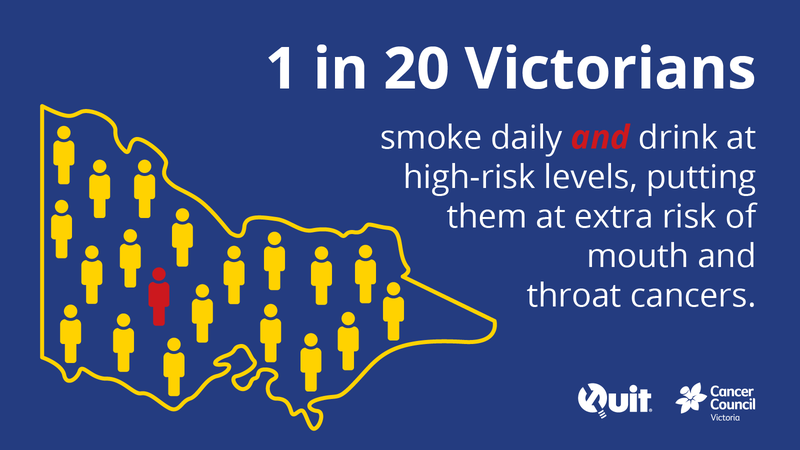A bad mix: tobacco and alcohol together increase cancer risk
Individually, tobacco and alcohol cause thousands of cancer diagnoses in Australia each year. But what many aren’t aware of is that for some cancers, the combined effect of alcohol and tobacco is even greater than the sum of their individual effects.

In fact, the risk of developing mouth and throat cancers has been found to be up to seven times greater for people who use tobacco and up to six times greater for those who use alcohol, compared to those who don’t use either. While for heavy users of both alcohol and tobacco, this risk increases to up to 35 times greater.
This increased risk is because alcohol can enhance the toxic effects of cigarette smoke on some tissues, especially those in the upper respiratory tract.
Smoking is currently the leading risk factor contributing to disease burden in Australia, and causes many types of cancer with 1 in 8 cancer deaths in the country due to smoking. Alcohol is carcinogenic, which means it is a cause of cancer, and its consumption is linked to at least 7 types of cancer.
Jane Martin, Head of Alcohol Programs at Cancer Council Victoria explains “Although most people know that smoking causes cancer, the link between alcohol and cancer isn’t as well understood.”
A strong relationship between alcohol and tobacco exists in Victoria with those who smoke being more likely to be heavy drinkers and vice versa.
In the 2019 National Drug and Strategy Survey, one in 20 Victorians reported both smoking daily and drinking at high-risk levels. This use of both tobacco and alcohol was found to be more common among 30-39-year-old women and 18-29 and 40-59-year-old men.
The connection between drinking and smoking
Director of Quit Victoria, Dr Sarah White says that scientific research has established a strong link between smoking and drinking; doing one increases cravings for the other which leads to consuming more of both.
“Many people smoke more cigarettes when they’re drinking because there is a neurological interplay between nicotine and alcohol. Alcohol increases the level of feel-good chemicals produced in the brain from nicotine, leaving you wanting more of it.”
There’s a similar, reciprocal response between cigarettes and alcohol cravings. Nicotine affects how the brain responds to alcohol, leading you to need to drink more to get the same feel-good response as a non-smoker.
How to reduce your risk
Any amount of alcohol and tobacco smoking increases your risk of cancer, but the good news is you can take steps today to reduce your risk:
Quitting smoking
There’s no safe level of smoking. Even smoking one or two cigarettes a day or smoking occasionally (“only on the weekends”) significantly increases your risk of dying from smoking-related illnesses.
Dr White says the best thing you can do for your health is to stop smoking. “As soon as you stop smoking, your body will begin to repair and over time, your risk of chronic disease, including heart disease, stroke and cancer drops significantly.”
“Whether or not you’re ready to quit, contacting Quitline on 13 78 48 or quit.org.au can help. Quitline counsellors can help you build or maintain motivation to quit or answer any questions you may have. When you’re ready, they can help you build a stop smoking plan that works for you.”
“For example, Quitline counsellors can give you advice about taking a break from alcohol which can be extremely helpful in the first few weeks of trying to quit,” said Dr White.
“People who have quit or are trying to quit tell us that drinking alcohol is the number one reason for relapse, partly because alcohol weakens willpower and partly because the brain then craves nicotine. The Quitline team can give you good strategies about how to avoid triggers to smoke when you’re out with friends.”
Contact Quitline today on 13 78 48 to speak to a qualified counsellor for non-judgement advice and support. Alternatively, you can request a call-back via our online form. For more information on stopping smoking and to access free online tools and resources, visit the Quit website.
Limiting alcohol
Contrary to popular belief, there is no safe level of drinking when it comes to cancer risk. If you do drink, the best way to reduce your risk is to reduce the amount you drink.
New guidelines released by the National Health and Medical Research Council recommend that adults have no more than four standard drinks on any one day and no more than 10 standard drinks a week to reduce their risk of injury or disease caused by alcohol.
Ms Martin says that understanding how much a standard drink is can be helpful to keep below the recommended amount.
“The size of a standard drink can vary depending on the type of alcohol and even the shape of the glass. Having a good understanding of what a standard drink looks like can be a helpful first step to reducing your intake and risk of alcohol-related disease.”
Cancer Council Victoria's Standard Drink Calculator is a useful tool to test your knowledge of a standard drink and help you visualise exactly how much a standard drink really is for different types of alcohol.
For more information on alcohol and cancer and how to reduce your risk, as well as tips and advice to help you reduce your intake, visit Cancer Council Victoria's Limit Alcohol page.
